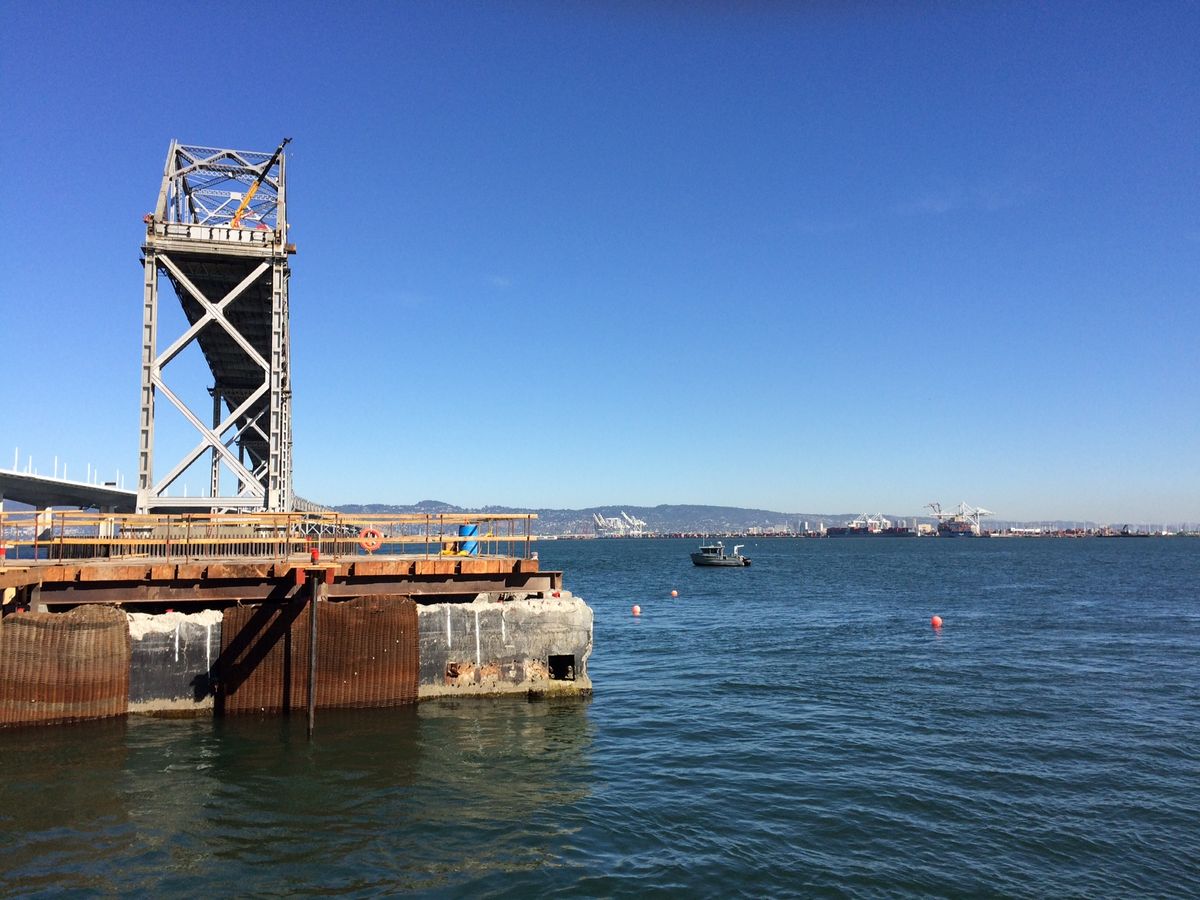
Residents of San Francisco and Oakland may get a booming treat early Saturday morning.
Engineers are planning to implode one of the major piers that held up the old Bay Bridge, which was decommissioned last year and has been gradually dismantled ever since. But exactly how do you blow up 20 million pounds (907,000 kilograms) of concrete, most of which lies under the water and buried 165 feet (50 meters) deep in the mud? It turns out, the science of blowing something up isn't so simple.
The massive operation involves everything from a "bubble curtain" to absorb the shock wave to a giant steel mat to catch debris. Those who are interested in seeing the underwater explosion can watch live on the Caltrans website tomorrow (Nov. 14), between 6:45 a.m. and 7 a.m. Pacific time. [Top 10 Greatest Explosions Ever]
Bye, bye, Bay Bridge
The Old Bay Bridge was decommissioned in 2014 and ever since, Caltrans, the government agency that runs the bridge, has been slowly dismantling the relic, which is made up of more than 58,000 tons of steel and 245,000 tons of concrete, according to San Francisco-Oakland Bay Bridge Seismic Safety Projects.
But a few pesky parts of the bridge were causing problems. In particular, Pier E3, a concrete behemoth that lies beneath the bay, was slated to be dismantled by hand with hacksaws and dams. The effort would have cost $254 million and required building a watertight wall around the mostly buried pier — an area that would then be pumped dry so that workers could go in to disassemble the pier. That process was also expected to take four years, according to Caltrans.
Blow it all up
Sign up for the Live Science daily newsletter now
Get the world’s most fascinating discoveries delivered straight to your inbox.
So engineers looked into other options.
The new plan? Blow it all up! (Isn't that always the best plan?)
Though that may sound exciting, the view from above won't be anything to write home about. Because the implosion will occur under the water (and mud), relatively little will be visible from the nearby bridge. The implosion may be loud, but the entire affair will be over in 6 seconds.
"It is approximately 135 decibels, which for a layperson is likely about what you would hear with a loud car stereo," said Leah Robinson-Leach, the Bay Bridge spokeswoman for Caltrans.
The plan is to bury 600 tiny explosives in pre-drilled holes in the structure and detonate them in a tightly choreographed 6-second sequence. As the 50 feet (15 m) of concrete at the top of the pier implodes, the debris will fall down into the massive, hollow base of the pier.
"Gravity will take hold and it will go into its base," Robinson-Leach told Live Science.
Any stray debris will be placed in the hole and then entombed and covered with dirt and mud found on the bay floor, she said.
The implosion is expected to kick up a fine plume of dust that should be visible in the water for hours. The whole operation will cost $160 million, according to Caltrans.
Reducing the impact
To limit the impact on local fish and other wildlife, the agency planned the operation for November, when the fewest numbers of birds, fish and marine mammals are lurking in the area. They also favored setting off 600 explosives, each weighing between 21 and 35 pounds (9.5 and16 kg), in multiple mini-blasts, rather than a massive single explosion; these tiny blasts have much less impact on wildlife, Robinson-Leach said.
The demolition engineers also devised a "blast-attenuation system," also known as a bubble curtain. Essentially, giant compressors placed on barges will pump air through perforated pipes placed on the floor of the bay. This will provide a continuous, thick curtain of bubbles to surround the pier, to absorb the energy of the shock waves.
"That is one technique that is being used to reduce the impact to the fish in the area," Robinson-Leach said. "It will reduce it by 80 percent."
Meanwhile, a heavy steel mat will prevent most of the debris from flying up from the blast.
"It's made of steel. It almost looks like a tightly woven fence," Robinson-Leach told Live Science. "It's extremely heavy, it's very thick."
Wildlife watchers
Just before the bridge implodes, a flock of wildlife and marine watchers will swarm to the area to keep lookout. The goal is to make sure that no marine mammals or birds stumble into the blast zone before the event. The agency is also halting traffic going in either direction along the bridge for about 15 minutes around the detonation. Though at least a few fish will likely die in the implosion, the implosion will likely harm fewer fish than the mechanical removal was expected to, CalTrans said.
For those who miss the implosion tomorrow, don't worry — there are still 21 other piers buried under the bay that need to be dismantled, and those too could be imploded if the current blast goes well, SFist reported.
Follow Tia Ghose on Twitter and Google+. Follow Live Science @livescience, Facebook & Google+. Original article on Live Science.

Tia is the managing editor and was previously a senior writer for Live Science. Her work has appeared in Scientific American, Wired.com and other outlets. She holds a master's degree in bioengineering from the University of Washington, a graduate certificate in science writing from UC Santa Cruz and a bachelor's degree in mechanical engineering from the University of Texas at Austin. Tia was part of a team at the Milwaukee Journal Sentinel that published the Empty Cradles series on preterm births, which won multiple awards, including the 2012 Casey Medal for Meritorious Journalism.












